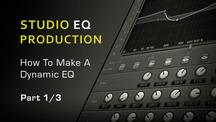Usually, a dynamic EQ is an equalizer with a compressor functionality on each frequency band. There are some good dynamic EQs out there, but today I’ll show you, how to make your own dynamic EQ out of your favorite EQ VST without such a dynamic feature - in Reaper.
To understand the principles of this shown solution, we start with a simple single band example, which we will expand in the second and third part. You need a basic understanding for how compressors work to use it here. If you don’t, please head over to the related article: http://www.loopmasters.com/articles/2999-Audio-Compressor-Basics-Understanding-What-Compressors-Do
Ok, let’s start with a basic example. For his I take a kickloop and a bassloop from the “Artisan - Future Deep House Electronica” sample pack (http://www.loopmasters.com/genres/50-Deep-House/products/3697-Future-Deep-House-Electronica). I put them each on a separate track and adjust the levels a bit. You hear, the kick and bass are kinda muddy when they are playing together. To give the kick sound more space, the bass should be lowered on each kick. Usually you’d tend to put a compressor on it and trigger it via sidechaining, but you’d have a very audible “pumping” effect, which MAY be considered, but not here. We just want to give the kick more space without having an obvious pumping.
Ok, let’s check with a frequency analyzer like the BlueCat FreqAnalyst (http://www.pluginboutique.com/product/25-Spectral-Analysis/273-Blue-Cat-s-FreqAnalyst) where the kick has its peak. We see, that the deep main peak sits between 40 and 50Hz. That’s the area we want to thin out at the bass. Obviously that’s a very low area, so you need *good* headphones or a subwoofer to recognize the changes we’ll made in a second.
Ok, let’s add an equalizer on the bass track. I choose DMG Equality, because it’s my go-to EQ nowadays. You can choose your very own favorite EQ now which supports automation (which is in fact every actual VST EQ), like Fabfilter Pro-Q 2 (http://www.pluginboutique.com/product/16-EQ/921-FabFilter-Pro-Q-2) or other.
Now I set the first bell shaped frequency band to 45 Hz (it’s the middle of 40 and 50 Hz ;)), and set the Q to around 2.5 to have the area from 40-50Hz covered, maybe plus a bit more. Now we want to have the EQ band triggered by the kickdrum, so we need a sidechain possibility. As usual in Reaper we’re using the channels 3 and 4 on that track. We have to enable them before we can use them, so open the EQ VST and click on the VST I/O routing button, which has the text “2 in 2 out” on it. Now click on the [+] sign on the left bottom and close that window.
Now you have enabled the 3rd and 4th channel of the track which we need for the sidechaining - even when the VST isn’t supporting it natively. Now let’s send the kickdrum signal to the sidechain input.
Open the track routing dialogue, click on the left side on the dropdown box with “Add new sends” on it and select “1: Am_120bpm_Bassline_1” in this case. it’s named like the sample we have dragged on the channel. Before you close that dialogue, set “Audio 1 / 2 => 3 / 4” and “Midi NONE”, which is just below of the send track name. Now close the dialogue. You’re sending now the kickdrum to the 3rd and 4th channel of the bass track - which is not audible.
Now let’s start the magic:
Switch back to the EQ, open it and click on the “Param” button on top of it. Bring the mouse over “FX paramater list”, then to “Parameter modulation” and finally click on “Band 2 Gain”, which is the desired band you want to change. Now the parameter modulation dialogue opens. Meanwhile you can start the playback by pressing the spacebar.
Now enable the first checkbox (if it’s not already enabled) “Enable parameter modulation, baseline value”, and double click the fader below, so it’s absolutely centered now.
Enable “Audio control signal” to reveal the options there.
Here you can set the options on how to handle the incoming signal. First of all, set the track audio channel to “3 / 4”, so it takes the kickdrum sound from the 3rd and 4th track channel.
Now lower the Attack value down to 0 (left).
The equalizer should now move, but in the wrong direction. Actually it’s a upward compression, which can be handy but is not desired now. To change that behaviour, set the “Direction” to “Negative” at the bottom of that dialogue.
And here we are:
You have a dynamic single band EQ which reacts to the kickdrum. You can control attack and release times as you like. In the window on the right side, you can set the envelope curve for attack and release. You should try around and bend the curve to see what it does, but for this example a linear behaviour is suitable.
Hint:
When you SOLO the bass track, you should hear the difference if you have good monitors or headphones. You can lower the Q factor in the equalizer (to widen the band) to have a more audible effect. Narrow it back, if the effect should be subtle (as desired). When you unsolo the bassline, turn the EQ on and off to listen to the difference. When the EQ is enabled, the kick sounds punchier.
When you MUTE the kick track, the band is not triggered, so you have no “pumping effect” when the kick’s not played!
*This is a guest post from Lopez who runs the label Electronic Anarchy and is involved in the develpment of Kirnu Cream








